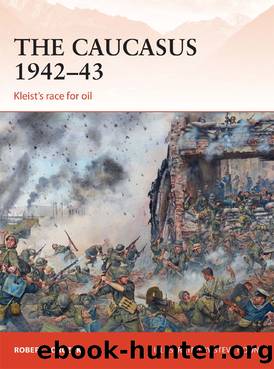The Caucasus 1942–43: Kleist’s race for oil (Campaign) by Robert Forczyk & Steve Noon

Author:Robert Forczyk & Steve Noon [Forczyk, Robert]
Language: eng
Format: azw3
Tags: The Caucasus 1942–, 43: Kleist’, s race for oil
ISBN: 9781472805850
Publisher: Osprey Publishing Ltd
Published: 2015-05-19T16:00:00+00:00
German troops cautiously approach a burning oil storage and trans-shipment facility at Maikop’s train station. Soviet sabotage rendered most of the region’s oil infrastructure useless for most of the Germans’ brief occupation. (Author’s collection)
After the capture of Pyatigorsk, von Schweppenburg called a temporary halt to all offensive action by his XXXX Panzerkorps. The combat units were all out of fuel and the logistical support units were far to the rear, some as far back as the Manych River. Numerous pockets of Soviet troops had been bypassed during the heady pursuit, but now they threatened von Schweppenburg’s tenuous lines of communications. It was time to consolidate the conquered areas and replenish the troops for a deliberate advance, rather than continuing on with a couple of battalions of motorcycle infantry and some armoured cars. The tip of von Kleist’s spear had outrun its supplies, giving Budyonny a vital breathing space.
While von Kleist’s pursuit was culminating in the foothills of the Caucasus Mountains, Ruoff’s 17. Armee was descending upon the city of Krasnodar with four infantry divisions from Wetzel’s V Armeekorps. The infantrymen had been marching 20km or more for two weeks through the desert-like terrain south of the Don and the heat and lack of water was particularly telling upon the horses that pulled their artillery. Ruoff’s army had lost over 950 horses since crossing the Don, which reduced the mobility of his divisions. In order to keep up with the fleeing Soviets, each of Wetzel’s infantry divisions formed a motorised Vorausabteilung by pooling all available trucks and cars, but this further deprived logistic units of vehicles essential to move supplies forward. Nevertheless, Wetzel’s corps closed in on Krasnodar, the capital of the Kuban and a city of 200,000 inhabitants. Krasnodar was a key target of Edelweiss since crude oil from Maikop and the nearby Krymskaya oilfield in the Taman Peninsula was sent to the city by pipeline, where the city’s refineries converted it into fuel. Budyonny could not simply abandon such a critical objective, so he ordered General-mayor Aleksandr I. Ryzhov’s 56th Army to make a stand there. Ryzhov’s army consisted of the 30th, 339th and 349th Rifle divisions and two separate artillery regiments, but they were in poor shape after the retreat from Rostov. Polkovnik Boris N. Arshintsev’s 30th Rifle Division was in the best condition, but the 339th Rifle Division only had 2,573 troops and the 349th Rifle Division just 1,137 troops (half of whom were unarmed). On 7 August, communist party officials began to mobilise 19,000 local residents – mostly teenagers and old men – to dig trenches and anti-tank ditches outside Krasnodar. Thousands of hastily levied militiamen were provided to Ryzhov to replenish his battle-worn divisions, but he remained very short of ammunition, weapons and radios.
While the Krasnodar militiamen were still looking for shovels to dig anti-tank ditches, Oberst Paul Scheuerpflug’s Vorausabteilung from 9. Infanterie-Division reached the northern outskirts of Krasnodar on the morning of 8 August, followed soon thereafter by elements of 73. and 125. Infanterie-Division.
Download
This site does not store any files on its server. We only index and link to content provided by other sites. Please contact the content providers to delete copyright contents if any and email us, we'll remove relevant links or contents immediately.
| Africa | Americas |
| Arctic & Antarctica | Asia |
| Australia & Oceania | Europe |
| Middle East | Russia |
| United States | World |
| Ancient Civilizations | Military |
| Historical Study & Educational Resources |
The Radium Girls by Kate Moore(11930)
100 Deadly Skills by Clint Emerson(4845)
Rise and Kill First by Ronen Bergman(4705)
The Templars by Dan Jones(4629)
The Doomsday Machine by Daniel Ellsberg(4420)
The Rape of Nanking by Iris Chang(4140)
Killing England by Bill O'Reilly(3953)
Hitler in Los Angeles by Steven J. Ross(3902)
Stalin by Stephen Kotkin(3883)
12 Strong by Doug Stanton(3511)
Hitler's Monsters by Eric Kurlander(3269)
Blood and Sand by Alex Von Tunzelmann(3140)
The Code Book by Simon Singh(3077)
Darkest Hour by Anthony McCarten(3072)
The Art of War Visualized by Jessica Hagy(2945)
Hitler's Flying Saucers: A Guide to German Flying Discs of the Second World War by Stevens Henry(2716)
Babylon's Ark by Lawrence Anthony(2622)
The Second World Wars by Victor Davis Hanson(2485)
Tobruk by Peter Fitzsimons(2447)
